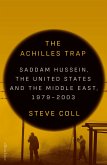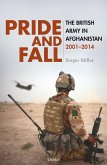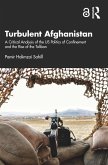Donald M. Snow
When Should America Fight?
Donald M. Snow
When Should America Fight?
- Broschiertes Buch
- Merkliste
- Auf die Merkliste
- Bewerten Bewerten
- Teilen
- Produkt teilen
- Produkterinnerung
- Produkterinnerung
Donald M. Snow invites readers to consider what criteria should be evaluated when considering whether the United States should engage in military action across the globe: when its vital interests are at stake and when the endeavor can reasonably be considered feasible. Special consideration is given to Afghanistan and Ukraine.
Andere Kunden interessierten sich auch für
![The Achilles Trap The Achilles Trap]() Steve CollThe Achilles Trap24,99 €
Steve CollThe Achilles Trap24,99 €![Pride and Fall Pride and Fall]() Sergio MillerPride and Fall34,99 €
Sergio MillerPride and Fall34,99 €![America's War for the Greater Middle East: A Military History America's War for the Greater Middle East: A Military History]() Andrew J. BacevichAmerica's War for the Greater Middle East: A Military History22,99 €
Andrew J. BacevichAmerica's War for the Greater Middle East: A Military History22,99 €![Extremism Extremism]() J. M. BergerExtremism22,99 €
J. M. BergerExtremism22,99 €![Turbulent Afghanistan Turbulent Afghanistan]() Pamir Halimzai SahillTurbulent Afghanistan42,99 €
Pamir Halimzai SahillTurbulent Afghanistan42,99 €![A Citizen's Guide to Terrorism and Counterterrorism A Citizen's Guide to Terrorism and Counterterrorism]() Christopher C. Harmon (Marine Corps University, Quantico, USA)A Citizen's Guide to Terrorism and Counterterrorism57,99 €
Christopher C. Harmon (Marine Corps University, Quantico, USA)A Citizen's Guide to Terrorism and Counterterrorism57,99 €![The Triple Agent The Triple Agent]() Joby WarrickThe Triple Agent21,99 €
Joby WarrickThe Triple Agent21,99 €-
-
-
Donald M. Snow invites readers to consider what criteria should be evaluated when considering whether the United States should engage in military action across the globe: when its vital interests are at stake and when the endeavor can reasonably be considered feasible. Special consideration is given to Afghanistan and Ukraine.
Hinweis: Dieser Artikel kann nur an eine deutsche Lieferadresse ausgeliefert werden.
Hinweis: Dieser Artikel kann nur an eine deutsche Lieferadresse ausgeliefert werden.
Produktdetails
- Produktdetails
- Verlag: Rowman & Littlefield
- Seitenzahl: 224
- Erscheinungstermin: 27. Januar 2023
- Englisch
- Abmessung: 229mm x 152mm x 13mm
- Gewicht: 352g
- ISBN-13: 9781538169445
- ISBN-10: 1538169444
- Artikelnr.: 65760809
- Herstellerkennzeichnung
- Libri GmbH
- Europaallee 1
- 36244 Bad Hersfeld
- gpsr@libri.de
- Verlag: Rowman & Littlefield
- Seitenzahl: 224
- Erscheinungstermin: 27. Januar 2023
- Englisch
- Abmessung: 229mm x 152mm x 13mm
- Gewicht: 352g
- ISBN-13: 9781538169445
- ISBN-10: 1538169444
- Artikelnr.: 65760809
- Herstellerkennzeichnung
- Libri GmbH
- Europaallee 1
- 36244 Bad Hersfeld
- gpsr@libri.de
Donald M. Snow is Professor Emeritus in the department of Political Science at the University of Alabama. Prior to this position he was visiting professor of international security studies at the U.S. Air War College. He is the author of numerous books and articles on national security, international conflict, and American foreign policy.
Preface
Introduction: The Withdrawal from Afghanistan and the Continuing Use of
American Force
Introducing the IF Factor
Vietnam, Afghanistan, and Beyond
The New Way of Fighting: Asymmetrical Warfare
The IF Contribution
Conclusion: The Legacy of Vietnam, Afghanistan, and Ukraine
Bibliography
Chapter 1: The United States in Vietnam and Beyond
The Context: Why Students Need to Know about War
The Post-World War II Evolution of Warfare
The Effects on Thinking About Warfare
Conclusion
Bibliography
Chapter 2: The Twentieth Century Legacy: The European Model of Warfare, the
Impact of Nuclear Weapons, and the Transformation of the Uses of Force
The European Style of War
The Impact of Nuclear Weapons
Conclusion
Bibliography
Chapter 3: The Systemic Shock of 9/11: Afghanistan, Iraq, and Beyond
America in Iraq
The War in Afghanistan
Conclusion: The Past in the Future?
Bibliography
Chapter 4: Russia and Ukraine in 2022: The Face of Modern Mayhem?
Defining Parameters in 2022: The Ukrainian Case
The Incendiary Potential of the 2022 Crisis: A Presage to a Larger War?
And Then There is Putin
The War Worthiness of the Ukrainian Crisis: Before and After the Impact of
Nuclear Weapons
Resolving the Ukrainian Crisis
Conclusion: The Nuclear Prophylactic?
Bibliography
Chapter 5: Contemporary Warfare and American Force: Conventional and
Asymmetrical Warfare in the World
Fighting in the Developing World: The IF Factor in Application
Contemplating Involvements: The Challenges of Asymmetrical Warfare
Assessing the Prospects: The Middle East Quagmire as Rejoinder
The United States and Potential Deployments Beyond the Traditional Middle
East Conflict
Asymmetrical Warfare 101
Asymmetry and the IF Factor
Asymmetrical Warfare Is Not Easy
The Dynamics of Defeating Intervention
Conclusions
Bibliography
Chapter 6: The Briar Patch of Intervention in a Complex Environment: The
Developed World
Dealing with the Modal Threats
The Russian Invasion of Ukraine
Conclusion: The Legacy of Ukraine?
Bibliography
Chapter 7: Coping with Asymmetrical and Conventional Forms of War: The
Challenge for American Expeditionary Force
"Traditional" War: Russia and Ukraine
Asymmetrical Pasts and Futures?
Asymmetrical Warfare in Europe?
The Ukraine War in Perspective
The Ukraine War, the American Response, and When America Should Fight
The IF Factor and the Ukrainian War
The Ukrainian Precedent
Bibliography
Chapter 8: Conclusion: Where Will and Should the U.S. Fight: The Road Ahead
The Recent Past as Prologue?
The Past as the Model of the Future?
The Ukrainian War
Asymmetrical War in the Developing World
Back to the Future: Where Should America Fight?
Peering into the Future
Projecting Forward
Bibliography
Introduction: The Withdrawal from Afghanistan and the Continuing Use of
American Force
Introducing the IF Factor
Vietnam, Afghanistan, and Beyond
The New Way of Fighting: Asymmetrical Warfare
The IF Contribution
Conclusion: The Legacy of Vietnam, Afghanistan, and Ukraine
Bibliography
Chapter 1: The United States in Vietnam and Beyond
The Context: Why Students Need to Know about War
The Post-World War II Evolution of Warfare
The Effects on Thinking About Warfare
Conclusion
Bibliography
Chapter 2: The Twentieth Century Legacy: The European Model of Warfare, the
Impact of Nuclear Weapons, and the Transformation of the Uses of Force
The European Style of War
The Impact of Nuclear Weapons
Conclusion
Bibliography
Chapter 3: The Systemic Shock of 9/11: Afghanistan, Iraq, and Beyond
America in Iraq
The War in Afghanistan
Conclusion: The Past in the Future?
Bibliography
Chapter 4: Russia and Ukraine in 2022: The Face of Modern Mayhem?
Defining Parameters in 2022: The Ukrainian Case
The Incendiary Potential of the 2022 Crisis: A Presage to a Larger War?
And Then There is Putin
The War Worthiness of the Ukrainian Crisis: Before and After the Impact of
Nuclear Weapons
Resolving the Ukrainian Crisis
Conclusion: The Nuclear Prophylactic?
Bibliography
Chapter 5: Contemporary Warfare and American Force: Conventional and
Asymmetrical Warfare in the World
Fighting in the Developing World: The IF Factor in Application
Contemplating Involvements: The Challenges of Asymmetrical Warfare
Assessing the Prospects: The Middle East Quagmire as Rejoinder
The United States and Potential Deployments Beyond the Traditional Middle
East Conflict
Asymmetrical Warfare 101
Asymmetry and the IF Factor
Asymmetrical Warfare Is Not Easy
The Dynamics of Defeating Intervention
Conclusions
Bibliography
Chapter 6: The Briar Patch of Intervention in a Complex Environment: The
Developed World
Dealing with the Modal Threats
The Russian Invasion of Ukraine
Conclusion: The Legacy of Ukraine?
Bibliography
Chapter 7: Coping with Asymmetrical and Conventional Forms of War: The
Challenge for American Expeditionary Force
"Traditional" War: Russia and Ukraine
Asymmetrical Pasts and Futures?
Asymmetrical Warfare in Europe?
The Ukraine War in Perspective
The Ukraine War, the American Response, and When America Should Fight
The IF Factor and the Ukrainian War
The Ukrainian Precedent
Bibliography
Chapter 8: Conclusion: Where Will and Should the U.S. Fight: The Road Ahead
The Recent Past as Prologue?
The Past as the Model of the Future?
The Ukrainian War
Asymmetrical War in the Developing World
Back to the Future: Where Should America Fight?
Peering into the Future
Projecting Forward
Bibliography
Preface
Introduction: The Withdrawal from Afghanistan and the Continuing Use of
American Force
Introducing the IF Factor
Vietnam, Afghanistan, and Beyond
The New Way of Fighting: Asymmetrical Warfare
The IF Contribution
Conclusion: The Legacy of Vietnam, Afghanistan, and Ukraine
Bibliography
Chapter 1: The United States in Vietnam and Beyond
The Context: Why Students Need to Know about War
The Post-World War II Evolution of Warfare
The Effects on Thinking About Warfare
Conclusion
Bibliography
Chapter 2: The Twentieth Century Legacy: The European Model of Warfare, the
Impact of Nuclear Weapons, and the Transformation of the Uses of Force
The European Style of War
The Impact of Nuclear Weapons
Conclusion
Bibliography
Chapter 3: The Systemic Shock of 9/11: Afghanistan, Iraq, and Beyond
America in Iraq
The War in Afghanistan
Conclusion: The Past in the Future?
Bibliography
Chapter 4: Russia and Ukraine in 2022: The Face of Modern Mayhem?
Defining Parameters in 2022: The Ukrainian Case
The Incendiary Potential of the 2022 Crisis: A Presage to a Larger War?
And Then There is Putin
The War Worthiness of the Ukrainian Crisis: Before and After the Impact of
Nuclear Weapons
Resolving the Ukrainian Crisis
Conclusion: The Nuclear Prophylactic?
Bibliography
Chapter 5: Contemporary Warfare and American Force: Conventional and
Asymmetrical Warfare in the World
Fighting in the Developing World: The IF Factor in Application
Contemplating Involvements: The Challenges of Asymmetrical Warfare
Assessing the Prospects: The Middle East Quagmire as Rejoinder
The United States and Potential Deployments Beyond the Traditional Middle
East Conflict
Asymmetrical Warfare 101
Asymmetry and the IF Factor
Asymmetrical Warfare Is Not Easy
The Dynamics of Defeating Intervention
Conclusions
Bibliography
Chapter 6: The Briar Patch of Intervention in a Complex Environment: The
Developed World
Dealing with the Modal Threats
The Russian Invasion of Ukraine
Conclusion: The Legacy of Ukraine?
Bibliography
Chapter 7: Coping with Asymmetrical and Conventional Forms of War: The
Challenge for American Expeditionary Force
"Traditional" War: Russia and Ukraine
Asymmetrical Pasts and Futures?
Asymmetrical Warfare in Europe?
The Ukraine War in Perspective
The Ukraine War, the American Response, and When America Should Fight
The IF Factor and the Ukrainian War
The Ukrainian Precedent
Bibliography
Chapter 8: Conclusion: Where Will and Should the U.S. Fight: The Road Ahead
The Recent Past as Prologue?
The Past as the Model of the Future?
The Ukrainian War
Asymmetrical War in the Developing World
Back to the Future: Where Should America Fight?
Peering into the Future
Projecting Forward
Bibliography
Introduction: The Withdrawal from Afghanistan and the Continuing Use of
American Force
Introducing the IF Factor
Vietnam, Afghanistan, and Beyond
The New Way of Fighting: Asymmetrical Warfare
The IF Contribution
Conclusion: The Legacy of Vietnam, Afghanistan, and Ukraine
Bibliography
Chapter 1: The United States in Vietnam and Beyond
The Context: Why Students Need to Know about War
The Post-World War II Evolution of Warfare
The Effects on Thinking About Warfare
Conclusion
Bibliography
Chapter 2: The Twentieth Century Legacy: The European Model of Warfare, the
Impact of Nuclear Weapons, and the Transformation of the Uses of Force
The European Style of War
The Impact of Nuclear Weapons
Conclusion
Bibliography
Chapter 3: The Systemic Shock of 9/11: Afghanistan, Iraq, and Beyond
America in Iraq
The War in Afghanistan
Conclusion: The Past in the Future?
Bibliography
Chapter 4: Russia and Ukraine in 2022: The Face of Modern Mayhem?
Defining Parameters in 2022: The Ukrainian Case
The Incendiary Potential of the 2022 Crisis: A Presage to a Larger War?
And Then There is Putin
The War Worthiness of the Ukrainian Crisis: Before and After the Impact of
Nuclear Weapons
Resolving the Ukrainian Crisis
Conclusion: The Nuclear Prophylactic?
Bibliography
Chapter 5: Contemporary Warfare and American Force: Conventional and
Asymmetrical Warfare in the World
Fighting in the Developing World: The IF Factor in Application
Contemplating Involvements: The Challenges of Asymmetrical Warfare
Assessing the Prospects: The Middle East Quagmire as Rejoinder
The United States and Potential Deployments Beyond the Traditional Middle
East Conflict
Asymmetrical Warfare 101
Asymmetry and the IF Factor
Asymmetrical Warfare Is Not Easy
The Dynamics of Defeating Intervention
Conclusions
Bibliography
Chapter 6: The Briar Patch of Intervention in a Complex Environment: The
Developed World
Dealing with the Modal Threats
The Russian Invasion of Ukraine
Conclusion: The Legacy of Ukraine?
Bibliography
Chapter 7: Coping with Asymmetrical and Conventional Forms of War: The
Challenge for American Expeditionary Force
"Traditional" War: Russia and Ukraine
Asymmetrical Pasts and Futures?
Asymmetrical Warfare in Europe?
The Ukraine War in Perspective
The Ukraine War, the American Response, and When America Should Fight
The IF Factor and the Ukrainian War
The Ukrainian Precedent
Bibliography
Chapter 8: Conclusion: Where Will and Should the U.S. Fight: The Road Ahead
The Recent Past as Prologue?
The Past as the Model of the Future?
The Ukrainian War
Asymmetrical War in the Developing World
Back to the Future: Where Should America Fight?
Peering into the Future
Projecting Forward
Bibliography








